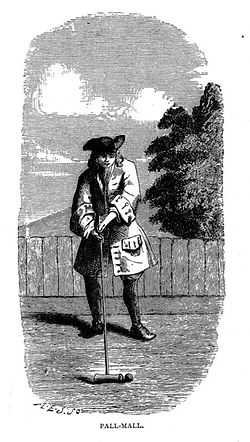Pall-mall
| Look up pell-mell in Wiktionary, the free dictionary. |

Pall-mall, paille-maille, palle-maille, pell-mell, or palle-malle (UK /pælˈmæl/, US /pɛlˈmɛl/, /pælˈmæl/ or /pɔːlˈmɔːl/) is a lawn game that was mostly played in the 16th and 17th centuries,[1]:306 a precursor to croquet.
History
Related to Italian trucco (also known as lawn billiards or trucks in English) and similar games, pall-mall is an early modern development from jeu de mail, a French form of ground billiards.
The name comes from the Italian pallamaglio, which literally means "mallet ball", ultimately derived from Latin palla and malleus meaning "ball" and "maul, hammer or mallet", respectively.[2] An alternative etymology has been suggested, from Middle French pale-mail or "straw-mallet", in reference to target hoops being made of bound straw.[1]:308
History in England
In 1661 Samuel Pepys wrote in his diary, "To St. James's Park, where I saw the Duke of York playing at Pelemele, the first time that I ever saw the sport".[3] In his book entitled "The sports and pastimes of the people of England" Joseph Strutt describes the way pall-mall was played in England in 1611:
- 'Pale-maille is a game wherein a round box ball is struck with a mallet through a high arch of iron, which he that can do at the fewest blows, or at the number agreed upon, wins.' It is to be observed, that there are two of these arches, that is 'one at either end of the alley.' The game of mall was a fashionable amusement in the reign of Charles the Second, and the walk in Saint James's Park, now called the Mall, received its name from having been appropriated to the purpose of playing at mall, where Charles himself and his courtiers frequently exercised themselves in the practice of this pastime.[4]
Whilst the name pall-mall and various games bearing this name may have been played elsewhere (France and Italy) the description above suggests that the croquet games were certainly popular in England as early as 1601. Some early sources refer to pall-mall being played over a large distance (as in golf), however an image in Joseph Strutt's 1801 book The Sports and Pastimes of the People of England clearly shows a croquet-like game (balls on ground, hoop, bats and peg) being played over a short (garden sized) distance. Interestingly this image describes the game as 'A very curious ancient pastime' and indeed a Saxon origin for this game has been suggested.
The game was still known in the early nineteenth century, as is proved by its reference in many English dictionaries. In Samuel Johnson's 1828 dictionary his definition of "Pall mall" clearly describes a game with similarities to modern croquet: "A play in which the ball is struck with a mallet through an iron ring".[5]
Game play
It was played in a long alley with an iron hoop suspended over the ground at the end. The object was to strike a boxwood ball of unknown circumference (a modern croquet ball is normally 3 5⁄8 inches (92 mm) in diameter,[6] which equates to approx 11 2⁄5 inches (29 cm), in circumference) with a heavy wooden mallet, down the alley and through the hoop with the fewest hits possible. Many references tell us that the ball was about 12 inches or 30 cm in diameter. However, it is known that this is not correct, as a ball of that size would be far, far too heavy to lift to a high height with a small mallet. Note the ball in the photograph. It is thought that the ball was likely in the region of 7 cm or slightly larger. It differed from trucco especially in its more extreme length of playing area, suggesting a closer relationship to golf than other derivatives of ground billiards.
Pall-mall was popular in Italy, France and Scotland, and spread to England and other parts of Western Europe in the 17th century. The name refers not only to the game, but also to the mallet used and the alley in which it was played. Many cities still have long straight roads or promenades which evolved from the alleys in which the game was played. Such in London are Pall Mall and the Mall, in Hamburg the Palmaille, in Paris the Rue du Mail, and in Utrecht the Maliebaan. When the game fell out of fashion, some of these "pall malls" evolved into shopping areas, hence the modern name of shopping centres in North America—shopping malls[7]—while others evolved into grassed, shady promenades, still called malls today.
References
- ↑ 1.0 1.1 Jusserand, J. J. (1901 [reprinted 1996]). Les sports et jeux d'exercice dans l'ancienne France. Paris: self-published. Check date values in:
|date=(help) - ↑ Almond, Jordan (January 1995). Dictionary of Word Origins: A History of the Words, Expressions, and Clichés We Use. Carol Publishing Group. pp. 182–183. ISBN 978-0-8065-1713-1. Retrieved 10 July 2013.
- ↑ Pepys' diary 2 April 1661
- ↑ Strutt, Joseph. Sports and pastimes of the people of england. p. 95.
- ↑ http://books.google.com/books?id=z3kKAAAAIAAJ&pg=RA2-PA519&dq=pelmel&lr=#v=onepage&q=&f=false
- ↑ The Croquet Association, www.croquet.org.uk/tech/index.html
- ↑
Coordinates: 51°00′44″N 13°51′50″E / 51.01222°N 13.86389°E